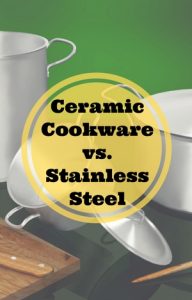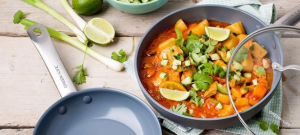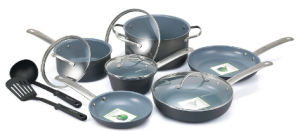 So you’ve realized it’s finally time to buy a new set of cookware. Should it be ceramic…stainless steel…or something else? Have you been struggling to make a decision on which type to buy? The popularity of ceramic cookware is rising more and more everyday, yet many folks still stand by their age-old favorite, stainless steel. Of course there are other popular choices too, but these two seem to be the top favorites right now. It can be a tough decision! If you’ve been debating between the two types, and wondering, is one better than the other? You should know both are good, but there are pros and cons to both of them you’ll want to consider. I’ll cover the main differences of both here relating to these aspects: health, cleanup, care, durability and cost. Hopefully, you’ll then have an easier time choosing which one is the best for you.
So you’ve realized it’s finally time to buy a new set of cookware. Should it be ceramic…stainless steel…or something else? Have you been struggling to make a decision on which type to buy? The popularity of ceramic cookware is rising more and more everyday, yet many folks still stand by their age-old favorite, stainless steel. Of course there are other popular choices too, but these two seem to be the top favorites right now. It can be a tough decision! If you’ve been debating between the two types, and wondering, is one better than the other? You should know both are good, but there are pros and cons to both of them you’ll want to consider. I’ll cover the main differences of both here relating to these aspects: health, cleanup, care, durability and cost. Hopefully, you’ll then have an easier time choosing which one is the best for you.
Health
So, regarding the health aspect, many folks are now becoming more health conscious than ever before in their buying choices and this includes cookware. The good news is that both types are non-toxic and safe to use (provided the surfaces are not damaged or worn). Neither one leeks out negative fumes or toxins. But if you’re looking to cut fats and oils from your diet, you’ll be pleased to know that very little oil or butter, if any, is used when cooking with ceramic pots and pans, such as one of my favorites by GreenLife. With stainless steel, you should know you’ll definitely have to use oil, butter, or a cooking spray to help prevent sticking (unless boiling, of course.)
CleanUp
Next is cleanup. Right off the bat, I’ll say that ceramic pots and pans are easier to clean than stainless steel. They have a non-stick surface that makes cleanup a breeze. And unless the surface has been damaged in any way, all it takes is some hot soapy water and a quick soft sponge and the pan is clean. Then just wipe dry right away, and that’s it. In some cases just a swipe of a paper towel will do, as well. Some brands can be used in the dishwasher, but most manufacturers don’t recommend it as the harsh dishwasher detergent can eventually ruin the non-stick coating. But since the pans are so easy to hand wash anyway, that may be a non-issue.
Stainless steel can be a bit harder to clean depending on what you’re cooking. In some cases, you’ll have to soak the pan and then use cleanser and steel wool, especially with burnt-on foods. The nice thing about stainless steel though, is that it’s completely dishwasher safe, and for most foods, not that difficult to clean.
Care
The next aspect to consider is the ease in caring for your pots and pans. I will say that caring for your ceramic coated pots and pans does require a bit of ‘babying’ to keep the non-stick coating performing well for you. Some manufactures recommend seasoning the pans first before using and then occasionally afterwards. You’ll also need to make sure you’re cooking with medium-medium low heat. That’s because the combination of the aluminum base and the non-stick coating provides super heat conductivity, so you should never need to go above a medium heat setting. You can even boil water and sear meat at lower temperatures. Using higher temps will damage to the coating.
One of the issues I’ve noticed regarding ceramic, is there are always some complaints about the food starting to stick or the pans not performing as they should. But I believe most of the problems are caused by using too high of heat temps. Many have had great success but they do state that it’s due to following all the manufacturer instructions. I’ve had great results with mine as well. You should also know that you’ll have to use silicone, nylon, or bamboo utensils instead of metal to protect against scratching the surface. There are a couple brands such as Gotham Steel (check my review here) that state you can use metal utensils, but even with these, I’ve found you do still have to be careful with using metal. So there are a few things you’ll have to remember to do differently than you may be used to, but soon they become habit and automatic. And by following the manufacturer’s specific instructions the pans will last longer and perform great for you.
On the other hand, caring for stainless steel cookware is pretty simple and convenient. The pans can be thrown in the dishwasher, you can use metal utensils, and if you do have burnt-on food, typically after soaking overnight and by using a non-abrasive cleanser like Bon Ami, vinegar or baking soda, they’ll clean up just fine.
Which is more durable? Both are durable but as far as how long they’ll remain durable depends on the care you use. I will say that stainless steel will typically last much longer, but it does come with a heftier price tag for a good brand.
Summing It Up
To sum things up, both are non-toxic and safe to use. By using the ceramic, you’ll enjoy the added health benefits of using less oil and fats (if any) in your cooking. The care and use though, does require following a specific set of instructions, however. But if followed, your food won’t stick (typically, eggs slide right out of the pan) and you’ll have pots and pans that clean up like a breeze. The stainless pans will require oil or fats to cook in most cases, and clean up can take a little more time, although they can be used in the dishwasher with no problems ruining the surface.
Stainless steel will be pricier for good pieces, but if taken care of properly, can last for 10-20 years or more! Ceramic coated pots and pans will not last near that long, but they’re a great option for someone needing a starter set that will last a couple years or more, or someone who doesn’t cook all that often and wants a cheaper alternative. With that said, there’s certainly nothing wrong with having both types in your cooking arsenal! For myself, I love frying eggs and meats, as well as reheating leftovers in my ceramic pans, and prefer to boil and cook stews or chili in my stainless steel pots. Hopefully, I’ve given you some guidelines to help you choose. If you’re leaning more towards ceramic cookware, check out some of my detailed reviews.

